Click image for BBB rating
See our Privacy Policy
cool="cool" width="784" height="8355" border="0" cellpadding="0" cellspacing="0" gridx="16" showgridx="showgridx" usegridx="usegridx" gridy="16" showgridy="showgridy" usegridy="usegridy" bgcolor="#99ccff">
|
|
|
 |
|
|
|
|
|
|
|
Welcome to Spaightwood Galleries, Inc.
120 Main Street, Upton MA 01568-6193
You can follow us on Facebook and Twitter!
We blog regularly on Facebook and announce special events and special sales on both sites.
Old Mastr Prints: Albrecht Dürer (Nuremburg, 1471-1528), The Engraved Passion
|
|
|
|
|
|
|
|
|
|
|
|
Durer worked on the Engraved Passion from 1507 to 1513, selling many of the sheets individually. Panofsky suggests that it had a very different audience in mind from that of the Small Woodcut Passion: "The format of the Engraved Passion differs from that of the Small [Woodcut] Passion by what may be called an aristocratic slenderness of proportion: It is about 4.5 by 3 inches as against 5x4. No text was considered necessary since it was not conceived as an edifying book but rather as a "collectors item," to be relished by the art lover instead of by the devout. In spite of its brevity (as compared to the Small [Woodcut] Passion) it has something sumptuous about it. It stresses spiritual suffering rather than physical torture and never loses sight of the preterhuman dignity of Christ." Vasari (1568 edition of the Lives in The Life of Pontormo) calls these "the ultimate in perfection and quality attainable in the medium as regards beauty, variety of vestments, and composition."
|
|
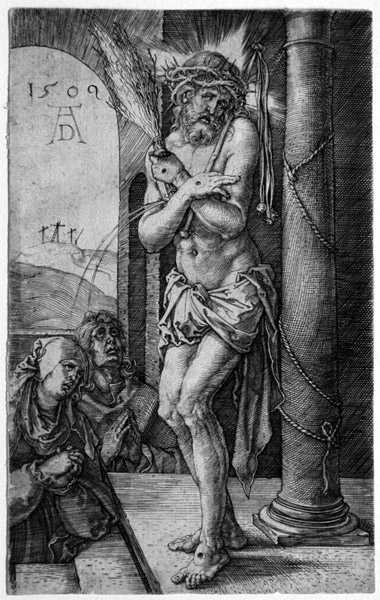 |
|
|
|
Albrecht Dürer (Nuremburg, 1471-1528), Man of Sorrows by the Column (Bartsch 3, Strauss 52). Original engraving, 1509.Here the resurrected Christ, showing the holes in his hands and feet where he was nailed to the cross, stands before the pillar at which he was beaten, holding the flail with which he was beaten, with the three empty crosses on Golgotha in the background, while his Mother and St. John the Divine contemplate him. Very good dark Meder b impression; thread margins or trimmed on the platemark; small losses left edge; small brown stain by stairs. Signed and dated with the monogram upper left. One of Durer's most famous engravings, it served as the frontispiece to the Engraved Passion. 116x75mm. Price: SOLD.
|
|
|
|
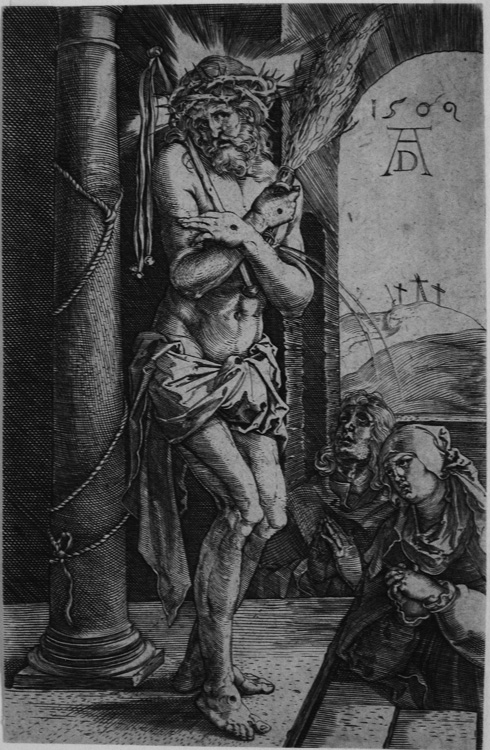 |
|
Man of Sorrows by the Column (Bartsch 3, copy 10). Engraving in reverse after Dürer's frontispiece for the Engraved Passion (c. 1509) published by Bundele later in the 16th impression. Here the resurrected Christ, showing the holes in his hands and feet where he was nailed to the cross, stands before the pillar at which he was beaten, holding the flail with which he was beaten, with the three empty crosses on Golgotha visible in the background above his mother and St. John the Divine who contemplate him. A very good dark impression trimmed within the platemark. Signed and dated with the monogram upper right. One of Durer's most famous engravings, it served as the frontispiece to the Engraved Passion. Strauss lists 15 copies in his Commentary volume on Dürer in The Illustrated Bartsch. 114x75mm. Price: Please call or email for current pricing information.
|
|
|
|
|
|
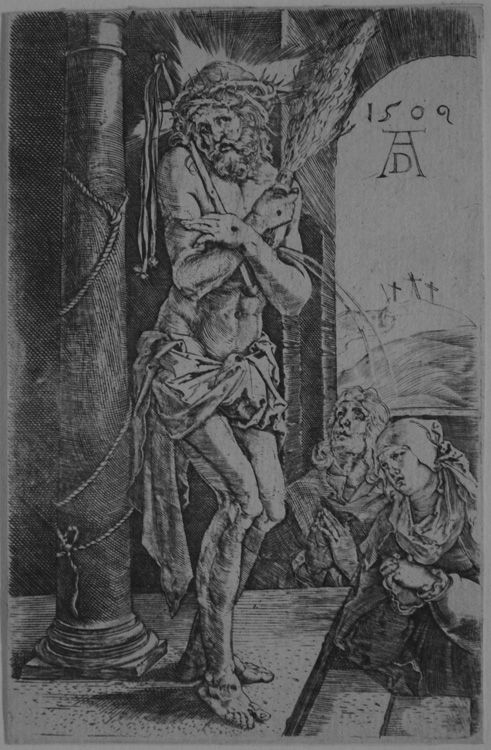 |
|
Man of Sorrows by the Column (Bartsch 3, copy 10). Engraving in reverse after Dürer's frontispiece for the Engraved Passion (c. 1509) published by Bundele later in the 16th impression. Here the resurrected Christ, showing the holes in his hands and feet where he was nailed to the cross, stands before the pillar at which he was beaten, holding the flail with which he was beaten, with the three empty crosses on Golgotha visible in the background above his mother and St. John the Divine who contemplate him. A later impression with thread margins or trimmed within the platemark. Signed and dated with the monogram upper right. One of Durer's most famous engravings, it served as the frontispiece to the Engraved Passion. Strauss lists 15 copies in his Commentary volume on Dürer in The Illustrated Bartsch. 117x75mm. Price: Please call or email for current pricing information.
|
|
|
|
|
|
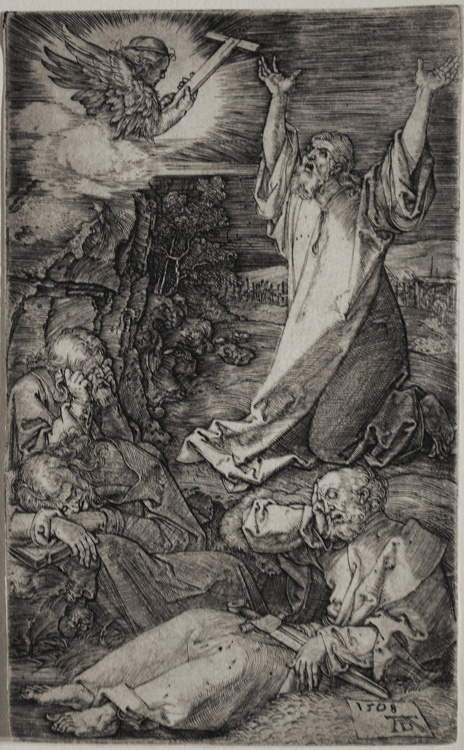 |
|
Albrecht Dürer (Nuremburg, 1471-1528), Agony in the Garden (Bartsch 4, Strauss 48). Original engraving, 1508. A fine Meder a/b impression with traces of burr printed on laid paper with part of a Bull's Head with Flower watermark (the 5-petal flower) not used after 1519. Meder notes that this watermark (#62), is found on first qualtiy impressions only. Signed with the monogram and dated on the tablet lower right. Image size: 115x71mm. Price: Please call or email for current pricing information.
|
|
|
|
|
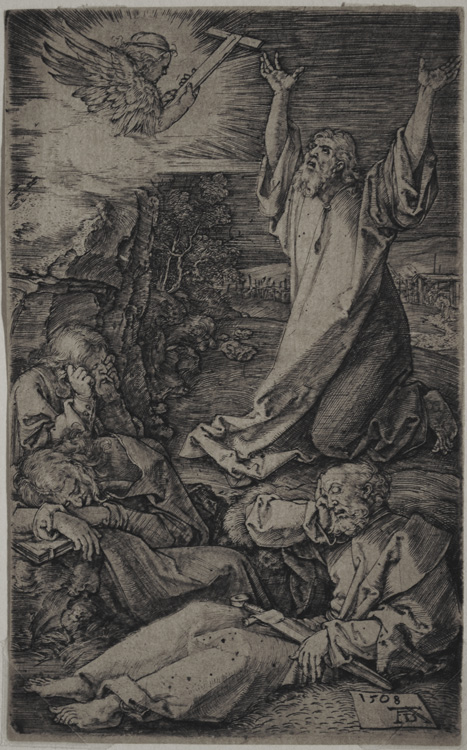 |
|
Albrecht Dürer (Nuremburg, 1471-1528), Agony in the Garden (Bartsch 4, Strauss 48, Meder 4 c/d). Original engraving, 1508. Signed with the monogram and dated on the tablet lower right. A good impression with less contrast than the impression above yet still sharply defined. Trimmed just outside the platemark on the bottom; trimmed on or within the platemark sides and top. Image size: 115x71mm. Price: Please call or email for current pricing information.
|
|
|
|
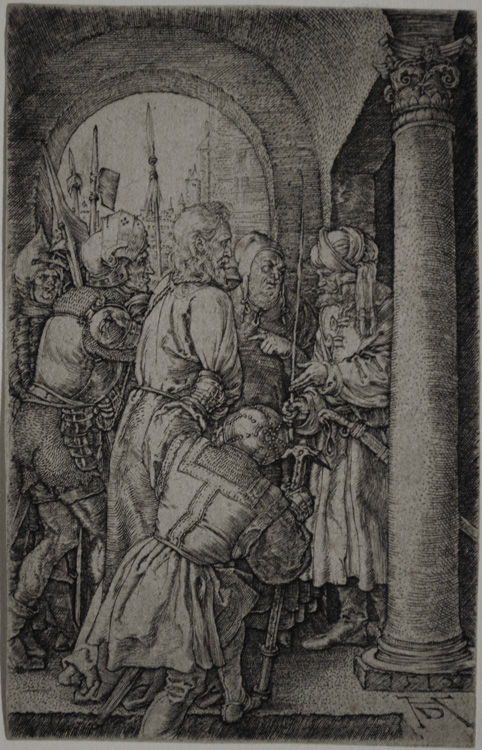 |
|
Albrecht Dürer (Nuremburg, 1471-1528), Christ before Pilate (Bartsch 7, Strauss 59, Meder 4b). Original engraving, 1512. Signed with the monogram and dated lower right on the bottom of the pillar. A good impression with less contrast yet still sharply defined. According to the Gospel of St. John 18: 28-32), "Then they took Jesus from Caiaphas to Pilate’s headquarters. It was early in the morning. They themselves did not enter the headquarters, so as to avoid ritual defilement and to be able to eat the Passover. So Pilate went out to them and said, 'What accusation do you bring against this man?' They answered, 'If this man were not a criminal, we would not have handed him over to you.' Pilate said to them, “Take him yourselves and judge him according to your law.” The Jews replied, “We are not permitted to put anyone to death.” (This was to fulfill what Jesus had said when he indicated the kind of death he was to die.)" Caiaphas stands to the left of Jesus talking to Pilate (a detail that owes more to the Passion Plays than to the Gospels). Pilate has not yet gone back inside the praetorium to interrogate Jesus and Jesus has not yet been mocked and flogged. Trimmed on or within the platemark. Image size: 119x75mm. Price: Please call or email for current pricing information.
|
|
|
|
|
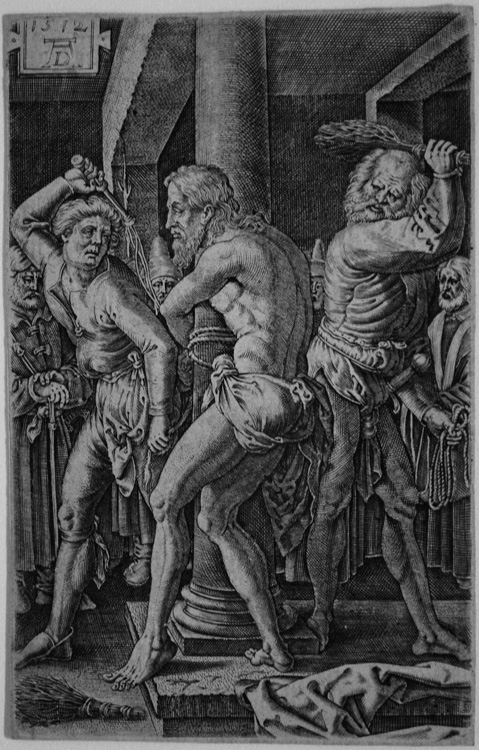 |
|
Willem de Haen, The Flagellation (Bartsch 10, copy 1). Engraving after Dürer's Flagellation for the Engraved Passion (1512) published in the late 16th-early 17th-century. De Haen was born in The Netherlands and was active in Cologne and Leyden. He engraved copies of a Engraved Passion. He added several additional twigs between Jesus' feet to distinguish between Dürer's original and his copy. Signed and dated 1512 with the monogram on the tablet upper left. Strauss lists 16 copies in his Commentary volume on Dürer in The Illustrated Bartsch. 115x72mm. Price: Please call or email for current pricing information.
|
|
|
|
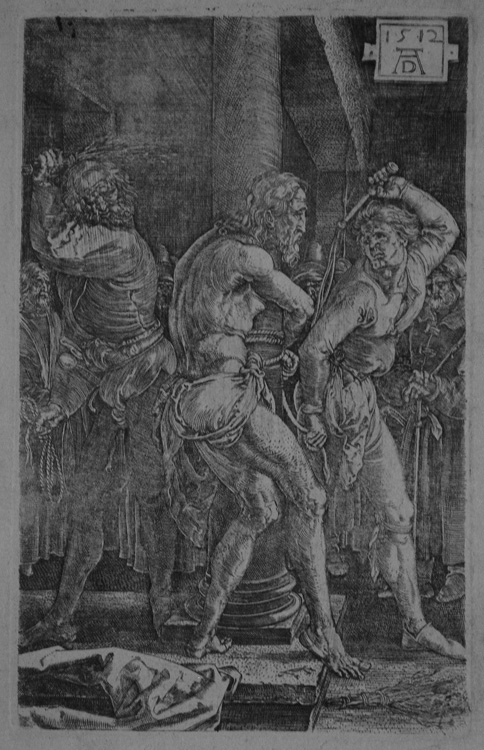 |
|
The Flagellation (Bartsch 10, copy 11). Engraving after Dürer's Flagellation for the Engraved Passion (1512) published by Bundele later in the 16th century. Here Jesus is presentewd to the people wearing his crown of thorns. A good impression with margins on all four sides; Strauss describes it as "Very exact except that the monogram and the date are formed somewhat differently." Signed and dated 1512 with the monogram on the slab lower right. Strauss lists 16 copies in his Commentary volume on Dürer in The Illustrated Bartsch. 115x74mm. Price: Please call or email for current pricing information.
|
|
|
|
|
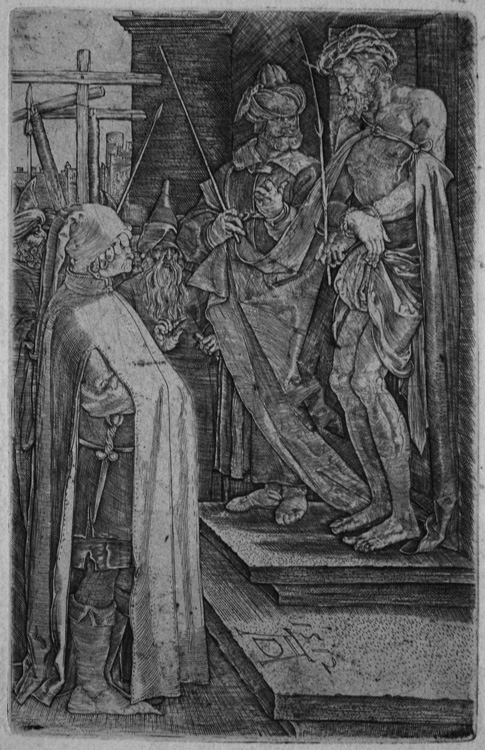 |
|
Ecce Homo (Bartsch 10, copy 11). Engraving in reverse after Dürer's Ecce Homo for the Engraved Passion (1512) published by Bundele later in the 16th century. Here Jesus is presentewd to the people wearing his crown of thorns. A good impression with margins on all four sides; Strauss describes it as "Very exact except that the monogram and the date are formed somewhat differently." Signed and dated 1512 with the monogram on the slab lower right. Strauss lists 16 copies in his Commentary volume on Dürer in The Illustrated Bartsch. 115x74mm. Price: Please call or email for current pricing information.
|
|
|
|
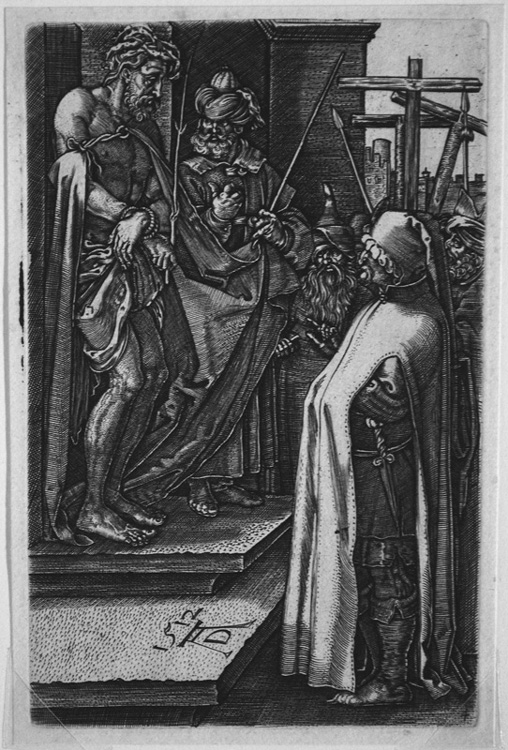 |
|
Ecce Homo (Bartsch 10, copy 6). A very deceptive engraving in reverse after Dürer's Ecce Homo for the Engraved Passion (1512) by Johann Ulrich Kraus (1655-1719). Kraus was an engraver and form-cutter in Augsberg. This is a deceptive copy on laid paper with the number 4 in the lower right corner as called for in The Illustrated Bartsch Volume 10 (Commentary) ed. Walter L. Strauss,. See pp. 37-39 for a history of copies of this striking engraving. Here Jesus is presented to the people wearing his crown of thorns. A good impression with margins on all four sides; Strauss describes it as "Very exact except that the monogram and the date are formed somewhat differently." Signed and dated 1512 with the monogram on the slab lower right. Strauss lists 16 copies in his Commentary volume on Dürer in The Illustrated Bartsch. 115x74mm. Price: Please call or email for current pricing information.
|
|
|
|
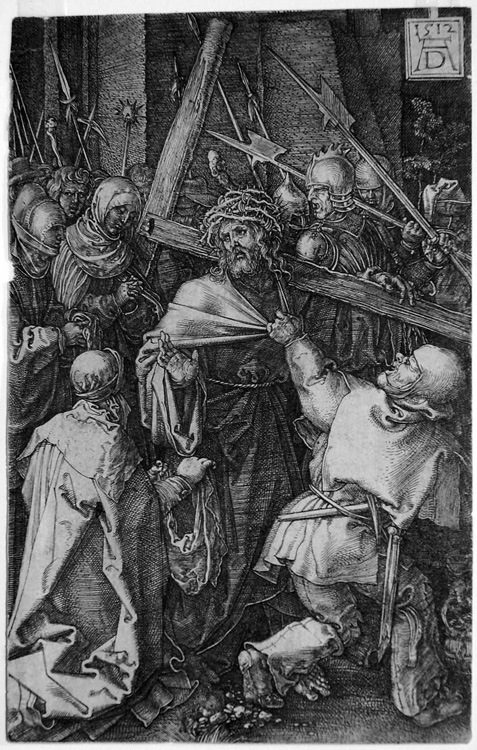 |
|
Christ Bearing the Cross (Bartsch 12, Strauss 64, Meder 12 iib). Original engraving, 1512. An early impression of this work for the Engraved Passion before the scratches on the guard's back. Signed with the monogram and dated 1512 upper right. Trimmed to the border; slight paper loss at left margin. The Gospels of Matthew, Mark and Luke all tell how the Roman authorities drafted Simon of Cyrene to carry the cross, as opposed to John 19:17, who specifies that Jesus carried the cross by himself, but only Luke 23: 27-31 contains Jesus' address to the women of Jerusalem: "A great number of the people followed him, and among them were women who were beating their breasts and wailing for him. But Jesus turned to them and said, 'Daughters of Jerusalem, do not weep for me, but weep for yourselves and for your children. For the days are surely coming when they will say, "Blessed are the barren, and the wombs that never bore, and the breasts that never nursed." Then they will begin to say to the mountains, "Fall on us’; and to the hills, ‘Cover us.’ For if they do this when the wood is green, what will happen when it is dry?” The kneeling woman, whom Jesus seems to be blessings, is St. Veronica, who can be seen holding the cloth that will receive the impression of Jesus's face (also seen in the Small Woodcut Passion [1509], the Large Woodcut Passion [c. 1498-99] and in two compositions where it is held by one or two angels for our consideration; click here to see them). Panofsky notes that "the rendering of this scene as a 'nocturne' is almost unprecedented" (Strauss, Engravings, p. 180). A very strong impression of one of Durer's most original compositions. Image size: 116x74mm. Price: Please call or email for current pricing information.
The photograph is slightly out of plane; the piece is a rectangle.
|
|
|
|
|
|
|
|
|
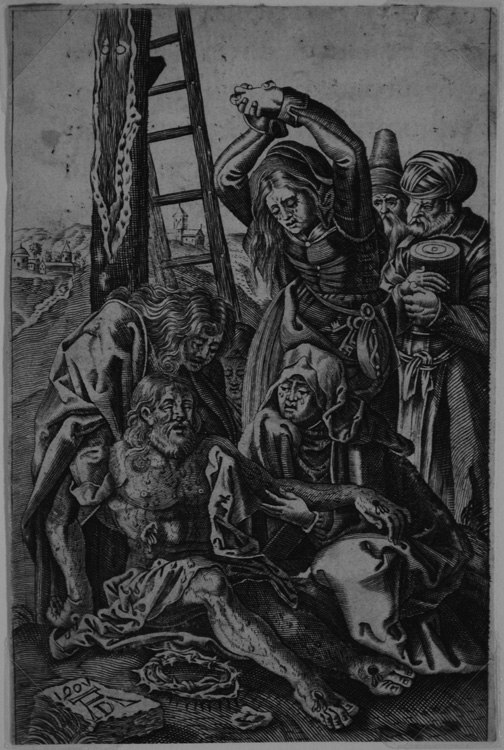 |
|
The Lamentation (Bartsch 14, copy 9). Engraving after Dürer's Lamentation for the Engraved Passion (1512). This copy was published by Bundele later in the 16th century. There is a printed text on the verso and the image shows wear and soiling from being read. Trimmed just outside the border lines on the sides and just inside them at top and bottom. This is the first sheet that Dürer executed for the Engraved Passion, which he began upon his return from his second trip to Italy in 1504 and stylistically it differs from most of the other sheets in the series. Strauss lists 18 copies in his Commentary volume on Dürer in The Illustrated Bartsch series, so it was clearly one of the most popular among its 16th- and 17th-century audience. Image size: 115x72mm. Price: Please call or email for current pricing information.
|
|
|
|
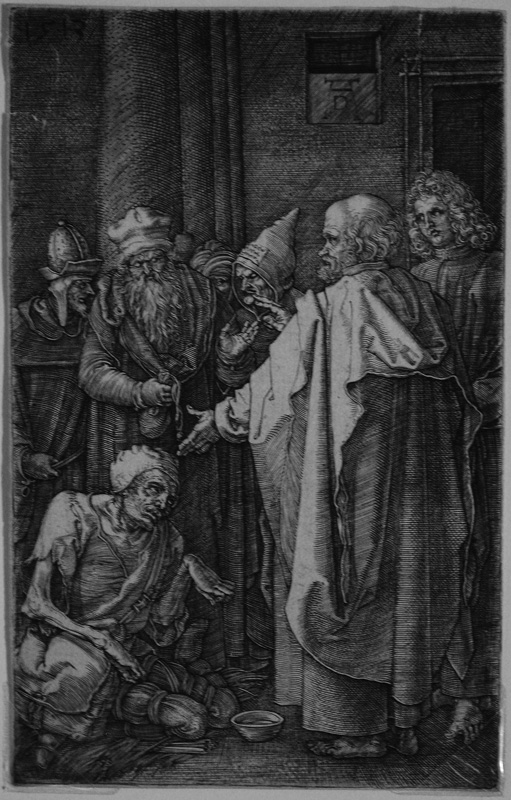 |
|
St. Peter and St. John Healing the Cripple (Bartsch 18, Strauss 68, Meder 18). Original engraving for the Engraved Passion (1513). Thread margins. This is the last sheet that Dürer executed for the Engraved Passion, which he began upon his return from his second trip to Italy in 1504 and stylistically it differs from most of the other sheets in the series. It is not part of the Passion, leaving open the possibility that Dürer was contemplating extending the series to include others of the Acts of the Apostles. A good, dark evenly-printed Meder a-b impression with strong contrasts. Two small 1/4 inches tears, one upper left and the other top right. Our restorer (who used to work at the Hermitage Museum in St. Petersburg) has examined these tears and says that repairs will not be complicated. As soon as the shows ends or someone purchases the work, we will have the repairs done. Image size: 116x73mm. Price: Please call or email for current pricing information.
|
|
|
|
Spaightwood Galleries, Inc.
To purchase, call us at 1-800-809-3343 (1-508-529-2511 in Upton MA & vicinity) or send an email to spaightwood@gmail.com.
We accept AmericanExpress, DiscoverCard, MasterCard, and Visa.
We also accept wire transfers and paypal.
For directions and visiting information, please call. We are, of course, always available over the web and by telephone (see above for contact information). Click the following for links to past shows and artists. For a visual tour of the gallery, please click here. For information about Andy Weiner and Sonja Hansard-Weiner, please click here. For a list of special offers currently available, see Specials.
All works are sold with an unconditional guarantee of authenticity (as described in our website listing).
Go back to the top of this page.
Visiting hours: Saturday 10:00 am to 5:00 pm and Sunday noon to 6:00 pm and other times by arrangement.
Please call to confirm your visit. Browsers and guests are welcome.
|
|
|
|
|
|
|
|
|
|
|
|
|
|
|
|
|
|
|
|
|
|
|
|
|
|
|
|
|
|
|
|
|
|












